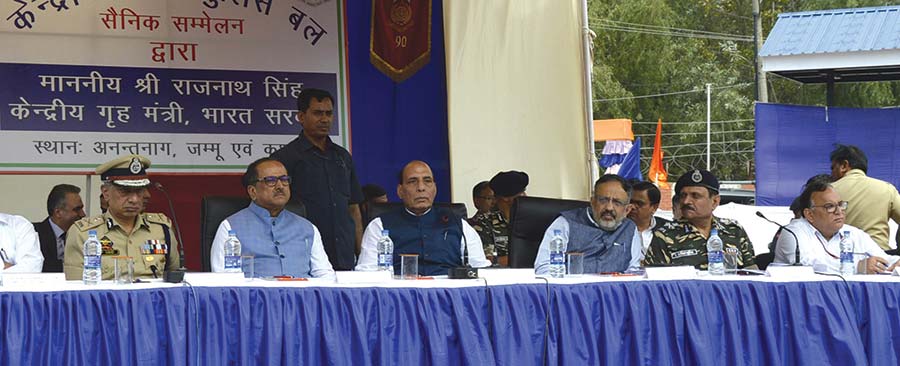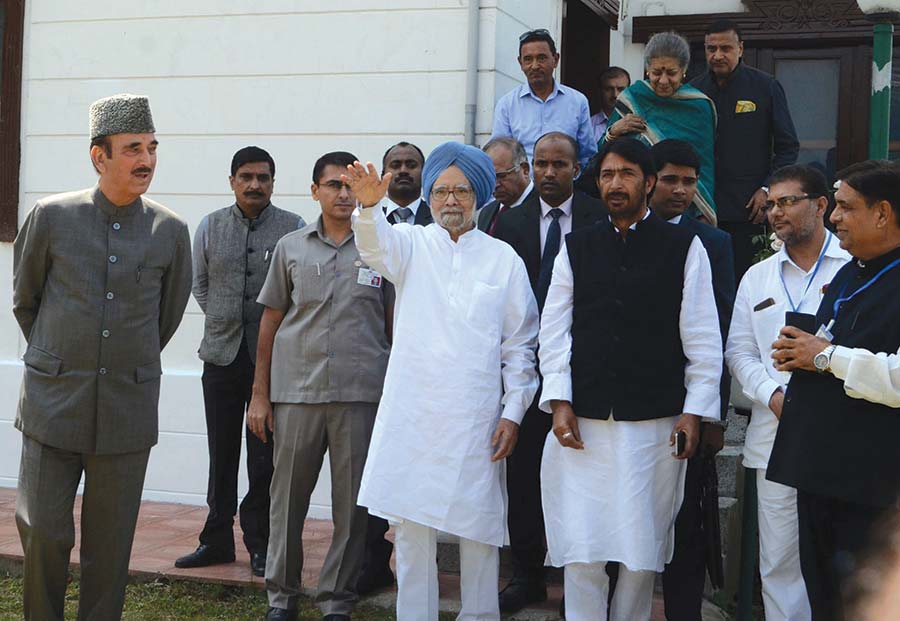The apparent semblance of a normal Kashmir led Rajnath Singh, the Home Minister, and Dr Manmohan Singh, the former Prime Minister, visit Kashmir. Notwithstanding their interactions with delegations lacking any consequence on ground, Khursheed Wani believes that the prevailing peace could prove farcical if the serious dialogue process involving Islamabad and Kashmir does not take off

For a complete year, Delhi left Kashmir affairs to the re-calibrated security grid to establish the lost grip on the unpredictable landscape. Mehbooba Mufti-led BJP-PDP coalition moulded itself to the new requirement of suppressing the dissent that had ruled the roost after Burhan Wani killing on July 8, 2016. The re-calibration of security grid was done after the abject failure of Rajnath Singh led 30-member all party parliamentary delegation (APD) in the first week of September 2016. In the follow-up, the security grid was given a free hand to quell the uprising. The period witnessed unprecedented curbs on separatist leadership, designated people found around the encounter sites as over-ground workers of militants liable for target killings. Hot pursuit led to raids and encounters, killing dozens of militants. Security grid tortured civilians, captured it in-camera and deliberately circulated to create scare. The infamous human shield incident of Farooq Ahmad Dar in Beerwah was hyped. Felicitating the ‘culprit officer’ Major Gogoi turned out to be part of the psychological operation.
Exactly, a year later, when anti-India street anger seldom exhibits, Delhi began initiatives to pick up threads again. In the second week of September, Rajnath Singh arrived in Kashmir for 4-day visit, arguably the longest stay of any home minister, with a theme to engage with all stakeholders. Almost simultaneously, the main opposition party in India, the Congress, dispatched a delegation led by former Prime Minister Dr Manmohan Singh to carry out a similar exercise. Singh started the journey from Jammu and concluded it in Srinagar meeting more than a hundred delegations and individuals for feedback on ground situation. After the two Singhs’ return to Delhi, all-powerful BJP general secretary Ram Madhav arrived for his own observations and interventions.
The newest interest of Delhi’s political class in Kashmir is not misplaced. The Kashmir situation has longer impact on the overall polity of India. The two major parties in India—BJP and Congress—have begun their preparations for 2019 elections through the alleys of Kashmir.
Rajnath Singh boasted his fifth visit to Kashmir in 14 months and promised to come as many times as he was required. Factually, he abandoned Kashmir for a complete year after the failure of APD. On his latest arrival he appeared to be confident and assertive if not altogether accommodative. He met as many as 74 delegations, addressed the press twice in Srinagar and Jammu and traveled to garrisons in Kashmir and Jammu, to assert that situation has been brought under considerable control after the last year’s upheaval.
The Home Minister repeatedly asserts that Delhi has embarked on a mission to find permanent solution to Kashmir problem linked his latest reach out to the Prime Minister Narendra Modi’s August 15, speech from the ramparts of Red Fort where he asserted that solution to Kashmir problem could not be found by bullets and abuses but by embracing the Kashmiri people.
On the face of it, the law and order situation has improved in Kashmir over the past several months. There are no processions of tens of thousands of people in support of azaadi, the killings and unbridled use of pellet guns have stopped and normal activities of people have largely resumed. The unionist political leaders are able to move around (notwithstanding grenade attack on R&B Ministwer Naeem Akhtar’s cavalcade at Tral that killed two civilians and injured 30 others) and semblance of developmental activities like blacktopping of roads and conduct of sports and tourism festivals are noticeable. The incidents of stone-throwing have lessened though the swell of people at the funerals of slain militants remains an invariable norm. Chief Minister moves around rather than sulking in her office chair or home sofa. This situation made Rajnath Singh to assert that trees of peace have not dried up in Kashmir as “I can clearly see the green shoots of peace”.
The situation has not come to this phase automatically. The confrontation between dissenters especially the rebels and security grid has not completely come to a halt though the security establishment seems to have regained the upper hand. Soon after the public uprising dissipated five months after Burhan’s killing, the security grid began an all-out synergized effort to crush the rebellion. The separatist political leadership that maneuvered the uprising was choked through arrests and unprecedented curbs on their movement. The army chief General Bipin Rawat declared stone-throwers trying to disrupt anti-insurgency operations as akin to militants and they were actually treated like that. So far this year 25 civilians were killed on being stone-pelters or onlookers at an encounter site. The biggest challenge to the security grid was, and continues to be, the presence of militants and a sudden swell in their number in the post-Burhan phase. Though there are around 227 militants active, both locals and foreigners, so far 145 stand killed including eight top-ranking commanders like Abu Dujana, Abu Ismail, Arif Lelhari and Yasin Yattu. The raids on hideouts are a common feature especially in south Kashmir region where 111 militants are operating. There is not a day when cordon and search operation is not conducted in any part of the region. The area domination has been enhanced to the extent that in Shopian district alone, six new army camps were established in recent months.
This state of affairs has instilled fear among the masses and the militants have resorted to reactionary tactic. Since January 58 security personnel have been killed in Kashmir, 26 of them constables and middle-rung officers of JKP. This is the highest number of police casualties in Kashmir during more than a decade.

On the other front, apart from curbing the movement of separatist leaders, the National Investigation Agency (NIA) began an exhaustive crackdown on alleged terror funding from across the border. Following a sting operation by a Delhi based TV channel that exposed few separatist leaders and activists conceding to be the recipients of funding, the NIA filed a case in May to crack whip on separatists. Several separatist leaders from both factions of Hurriyat, traders, lawyers and businessmen have been rounded up, formally arrested or thoroughly quizzed. The state government is encouraging the NIA and the operation has eventually shaken the separatists’ castle. Except Mian Abdul Qayoom, the president of High Court Bar Association, whose summoning by NIA evoked sharp resentment from lawyers’ community, no one has been given a clean chit by the NIA. Qayoom was grilled twice in Delhi before being let off. The separatist trio of Syed Ali Geelani, Mirwaiz Umar Farooq and Yasin Malik attempted to break the NIA tempo by announcing a symbolic protest at NIA headquarters in Delhi but the state authorities disallowed their travel.
So, the semblance of normalcy has a lot of military might and the tactical handling of situation in the backdrop. Kashmir is not completely normal because tourists have not returned. On slight apprehensions, the internet is snapped, educational institutions closed and prohibitory orders imposed in sensitive areas. For common people, this has become a new normal.
In this background, the emerging situation throws a bigger challenge. It is not for the first time that semblance of normalcy has resumed. There have been occasions when the militancy was completely wiped out from certain areas. The Kulgam district was once declared as militancy free zone but now it has thrown the highest number of fresh recruits to militancy.
Rajnath Singh spelled out his formula for Kashmir peace in five Cs: compassion, communication, co-existence, confidence building and consistency. This appears to be a roadmap and that the central government wants to arrive at the permanent solution of Kashmir problem.
The central government has to walk extra mile to alley the apprehension of the Kashmiri people. On his 5 Cs formula, this writer asked Rajnath Singh that he has ignored mention of the crucial C that stands for the special constitutional position of J&K under Article 370 and 35A, which is, off late, under threat and a cause of anxiety for common Kashmiris. Even as Rajnath Singh declared that Delhi won’t take any step that would hurt the sentiments of the people of state, the questions abound as to why the central government did not take steps to defend the constitutional position in the Supreme Court where the matter has been taken by an NGO supposedly affiliated to RSS. Though he described the controversy over article 35 A as non-issue, the matter has already caused a lot of political uncertainty and consternation in the region as it is being linked to the existence of the people. Privately, the ruling PDP leaders and ministers say that the central government will not fiddle with the special status of J&K but they fail to provide any concrete proof to allay the people’s apprehensions. More than the actual threat to the constitutional position, the PDP is wary of the internal political challenges. The opposition National Conference has begun its new politics on the imminent threats to the state’s special position from RSS-backed forces, taking a legal route.
Manmohan Singh-led Congress delegation also followed the same path for its intervention. Their doors too were vaguely open for everyone but there was no formal invitation to any group of individual. There was a beeline of people to meet the delegation that including Ghulam Nabi Azad and Ambika Soni, but most of the people who interacted were non-descript with no influence or acumen to impact the ground situation in Kashmir. There is no report that Manmohan Singh spoke his mind out. He only exchanged pleasantries and in his traditional style listened to the people. A senior Congress leader said that the overall impression was that the people wanted serious political interventions in Kashmir and enough safeguards to the special position of the state. “Kashmir is India and India is Kashmir,” is the basic premise where the Congress begins its interventions in J&K, the senior leader told this writer. “We have to focus on return of peace and re-engaging people in the mainstream fold,” he said. The Manmohan delegation’s observations would be made public after it concludes the third leg of their visit to Ladakh region, after Ashoora.
For tangible results on the ground, Kashmir watchers believe, political engagement with separatists and Pakistan is a pre-requisite. However, Rajnath Singh as also Manmohan Singh did not lay any importance to this aspect. Both the men from Delhi maintained they were willing to talk to anyone including separatists should they come forward. Rajnath refused to extend a formal invitation and also blamed Pakistan for not being forthcoming to peace overtures from India. Sans this crucial engagement, the road-map for permanent solution to Kashmir raises more questions than it answers.

